×

LEARN MORE ABOUT THE WORKSHOP KIT
Enter your email below and we will keep you updated as more information is released about the kit.

We talk a lot about the clarity of communication. To me that means how easy it is for a person in our audience to grasp what we are saying.
This is, I suggest, only ground level for powerful business communication.
The next level is to deliver a high-quality message. By my way of thinking this is a message that is not just clear, but which delivers significant value.
In most situations this requires a good degree of synthesis, and I thought sharing four key questions we ask might help you assess the quality of your own communication.
To test the quality of our messaging, we ask ourselves what level of message we have used.
I encourage you to review the three most recent pieces of communication you have prepared and assess what level your communication was at.
If you find very few level 4 messages ask yourself why and see if you can level them up in your next piece.
I hope that helps and look forward to bringing you more next week.
Davina

I love what I do.
I help senior leaders and their teams prepare high-quality papers and presentations in a fraction of the time.
This involves 'nailing' the message that will quickly engage decision makers in the required outcome.
I leverage 25+ years' experience including
My approach helps anyone who needs to engage senior leaders and Boards.
Recent clients include 7Eleven, KPMG, Mercer, Meta, Woolworths.
Learn more at www.clarityfirstprogram.com
(*) Numbers are based on 2023 client benchmarking results.

I had a fabulous question this week: where do we fit ‘pros' and ‘cons' in our storyline?
That is a ‘ripper' of a question.
My answer is this: lists of pros and cons don't belong in your communication, they help you think through that message.
Let me explain.
If we provide lists of pros and cons for an idea, we are providing information rather than insight. This matters, because in taking this approach we
If, instead, we do the thinking for our audience, we will deliver insights that emerge from our own analysis of the pros and cons list.
Although more intellectually challenging, this is better for us and our audience. We know more about the area than they do and we don't miss the opportunity to share our value add.
If your audience is explicitly asking for pros and cons lists, pop them in the appendix. Focus your main communication around your interpretation of that list.
Hopefully next time they won't ask for the list, but rather for your insights.
I hope that helps.
Kind regards,
Davina

I love what I do.
I help senior leaders and their teams prepare high-quality papers and presentations in a fraction of the time.
This involves 'nailing' the message that will quickly engage decision makers in the required outcome.
I leverage 25+ years' experience including
My approach helps anyone who needs to engage senior leaders and Boards.
Recent clients include 7Eleven, KPMG, Mercer, Meta, Woolworths.
Learn more at www.clarityfirstprogram.com
(*) Numbers are based on 2023 client benchmarking results.

I came to Friday's interview with Matt Lohmeyer a bit selfishly. Negotiating has often made me nervous and yet he seems to thrive while discussing and doing it.
So, I wanted to learn how he gets great outcomes while actually enjoying the process.
If I am to interpret Matt correctly, the ‘insight' is to explore ‘possibility’ and seek out ‘opportunity’ rather than be driven by the fear of being cornered by a win/lose proposition.
Here are three fear busters that I took away that I hope help you also.
Let me now give you some more detail about these before offering the video recording and two powerful and free tools from Matt.
1 – Deal with the hairy beasts first. By that, Matt suggests dealing with the most difficult issues of a negotiation first. He recommends agreeing the negotiation strategy at the beginning as a way to build rapport, rather than dealing with small items. An example might help.
At the beginning you might ask the other person (note, I am deliberate in not saying ‘the other side') to identify their biggest concern. You might even suggest that you think item X is going to be the most difficult thing to resolve.
This gives them an opportunity to agree or to indicate that item Y or Z is a bigger deal for them. Taking this approach offers many advantages. You
2 – See popular techniques as tools rather than the primary strategy. Matt suggests that emphasising win-win solutions or splitting the difference results in mediocre outcomes. Why?
Because they leave you thinking small. They lead you to
3 – Avoid saying no, and frame your response as a possible alternative. This doesn't mean NEVER saying no as Matt was quick to point out, but rather avoid saying it.
To give an example. Instead of saying ‘No, I can't have coffee with you tomorrow afternoon', say ‘I could have coffee with you at 9am tomorrow at a location near me'.
This then puts the onus back on the other person to decide whether they will make the extra effort to make that time and location work.
This is a simple example, but a powerful principle that empowers me by offering a constructive way out.
These are just some of the gems that Matt shared. You can visit the recording below as well as download two powerful resources he has for us all.
1. A diagnostic to help you calibrate your personal blend of preferred negotiation strategies with the norm group of over 2,500 other executives. How do you actually negotiate? To unlock this tool, you will need to use the password Mythbusters.
2. A generously detailed PDF full of negotiation strategies for you to employ – register below to receive access to Matt's eBook:
Kind Regards,
Davina

I love what I do.
I help senior leaders and their teams prepare high-quality papers and presentations in a fraction of the time.
This involves 'nailing' the message that will quickly engage decision makers in the required outcome.
I leverage 25+ years' experience including
My approach helps anyone who needs to engage senior leaders and Boards.
Recent clients include 7Eleven, KPMG, Mercer, Meta, Woolworths.
Learn more at www.clarityfirstprogram.com
(*) Numbers are based on 2023 client benchmarking results.

I had a terrific question from a client today that highlighted a common strategic challenge.
How do we use a storyline to create a ‘paper for noting’?
These are papers that aren't asking for a decision but truly updating our audience on a topic. For example, they might do one of these things:
In this situation Adrian was concerned that he didn’t have a ‘so what’ (which is a tale for another day … what really IS a so what after all?).
Rather, he wanted his Board to be aware of a problem so they were ready to hear about his business case in a couple of months’ time.
So, what to do?
In this case Adrian decided to ask the Board to endorse his plan to prepare a business case to address the problem he was facing.
This strategy alerted the Board to the existence of the problem, demonstrated early that the team was taking action and provided clarity around the near-term steps the team would take to address it.
I hope that’s useful and look forward to sending more ideas through next week.
Kind regards,
Davina
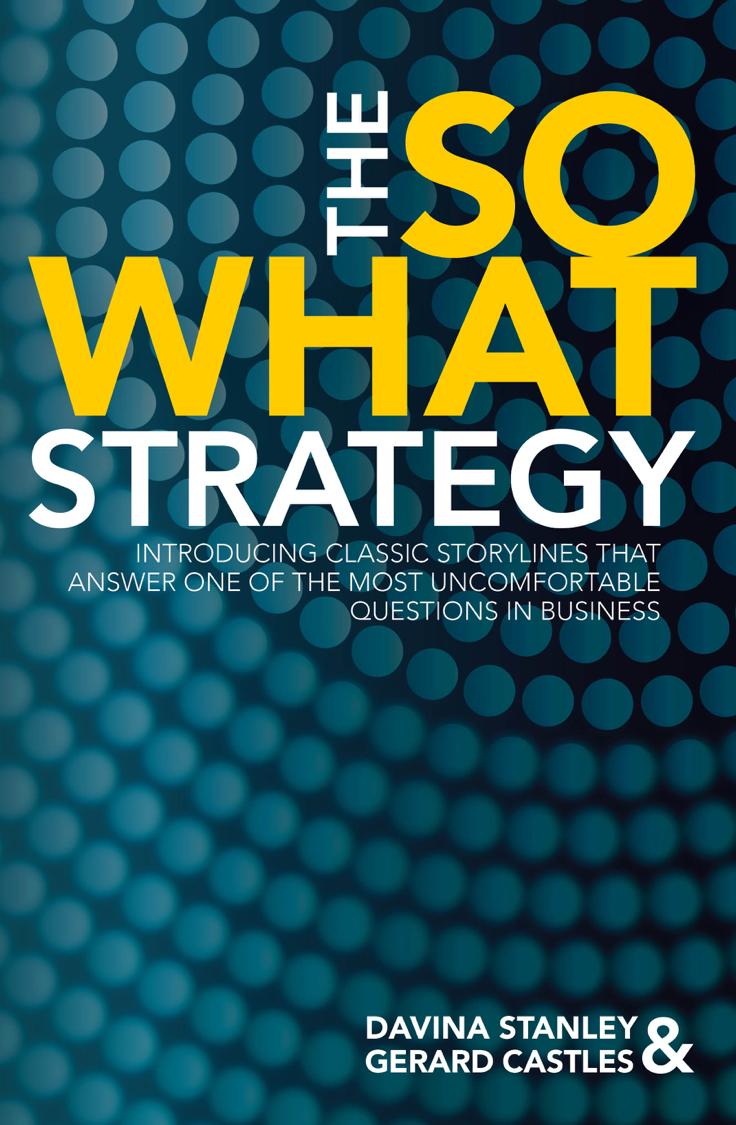
Learn how to communicate complex ideas that cut through using our practical book. We share our seven favourite storyline patterns while also discussing two practical scenarios for each: one operational, one strategic.
Never be asked “So, what does that mean?” again.
Click here to learn more.

I love what I do.
I help senior leaders and their teams prepare high-quality papers and presentations in a fraction of the time.
This involves 'nailing' the message that will quickly engage decision makers in the required outcome.
I leverage 25+ years' experience including
My approach helps anyone who needs to engage senior leaders and Boards.
Recent clients include 7Eleven, KPMG, Mercer, Meta, Woolworths.
Learn more at www.clarityfirstprogram.com
(*) Numbers are based on 2023 client benchmarking results.

I was recently asked a wonderful question:
The client and I had a terrific discussion and I mapped the outcome as a decision tree to share with you all.
The tree offers a series of decision points that we must navigate if we are to deliver a story that gets the result we need.
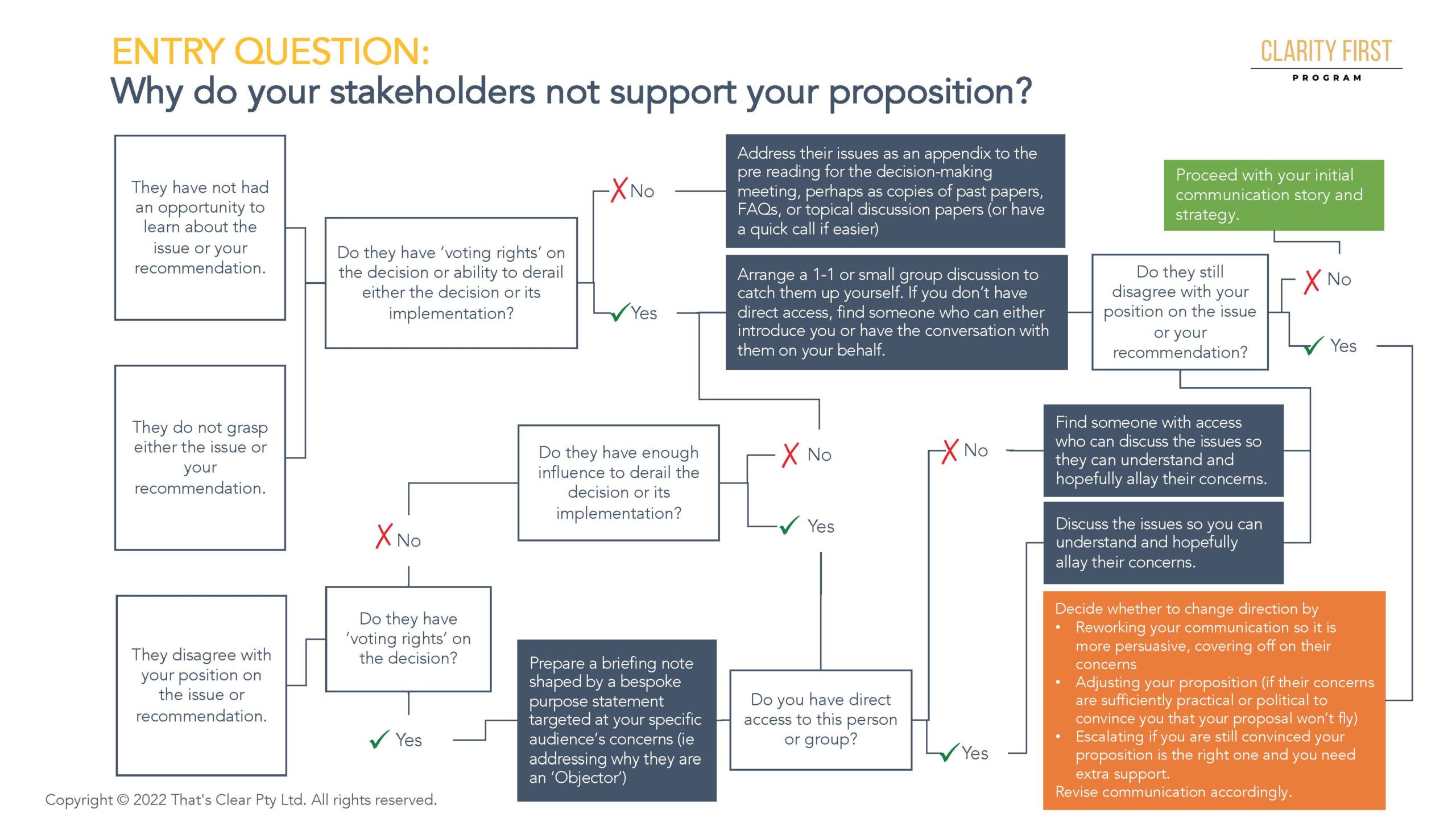
In this particular case, the issue centred around around a common problem, which was how to handle ‘the story' when key stakeholders don't agree with it. Do we ….
Tell the same story regardless?
Edit the story to accommodate that person (or those people) only?
Ask someone else to present on our behalf?
Create a separate story that deals with the objector's specific concerns?
Scrap the story and start again?
There are lots of alternatives, each of which might suit a different situation but none of which suit all.
Hence, the decision tree. I hope you find it useful.
Cheers, Davina

I love what I do.
I help senior leaders and their teams prepare high-quality papers and presentations in a fraction of the time.
This involves 'nailing' the message that will quickly engage decision makers in the required outcome.
I leverage 25+ years' experience including
My approach helps anyone who needs to engage senior leaders and Boards.
Recent clients include 7Eleven, KPMG, Mercer, Meta, Woolworths.
Learn more at www.clarityfirstprogram.com
(*) Numbers are based on 2023 client benchmarking results.

TLDR. Developing strategies is hard. Structured thinking can help.
Two of this week's coaching sessions shone a very bright light on how structured thinking is about much more than ‘putting words on a page'.
It's also about clarifying those ideas in the first place.
Today I'll focus on how you can use a structured message map rather than how you build one.
Let me give you the high level story first and then explain by way of example.
Pyramid Principle is a tool for mapping your ideas, which can also be described as a thinking machine.
One of my old colleagues went so far as to call it an ‘insight engine'.
This is true if we test whether our ideas are organised according to the structured thinking ‘rules'.
If they don't, we can use the rules to work out what is wrong and to strengthen or replace the ‘misfit' ideas.
This both pushes and guides us so we think harder and communicate more impactfully.
In the classic sense, we can structure our messaging to prepare communication so it engages our audiences better.
The structured thinking rules that make the ‘machine' work provide an opportunity to use storylines to develop our strategies, not just describe them. This can be particularly effective when we collaborate with our colleagues.
This is where this week's coaching comes in.
In both sessions, we prepared a story that participants would deliver to their senior leadership in our final workshop.
The stories needed to be practical and focus on real-life problems that were substantive enough to engage their leaders.
The challenge for these two groups was that they were not in the midst of a natural paper cycle, and so didn't have anything big enough to share.
Our solution was to use our coaching session to structure a communication for a solution, even though they had yet to identify that solution.
In one case, the team developed a strategy to fine-tune their recent organisational transformation to agile ways of working.
In the other, they did two things. They
It worked a treat. I thought these were great examples of how thinking through a ‘communication' was much more than that.
In both sessions we developed new strategies to solve new problems while practicing our ‘communication skills'.
Structuring your messaging has a deeper purpose, which you can take advantage of once you really lean into the Pyramid Principle's rules.
I hope that helps.
Kind regards,
Davina
PS – To learn more, try my free 10 Minutes to Better Emails course, or check out my latest books.

I love what I do.
I help senior leaders and their teams prepare high-quality papers and presentations in a fraction of the time.
This involves 'nailing' the message that will quickly engage decision makers in the required outcome.
I leverage 25+ years' experience including
My approach helps anyone who needs to engage senior leaders and Boards.
Recent clients include 7Eleven, KPMG, Mercer, Meta, Woolworths.
Learn more at www.clarityfirstprogram.com
(*) Numbers are based on 2023 client benchmarking results.
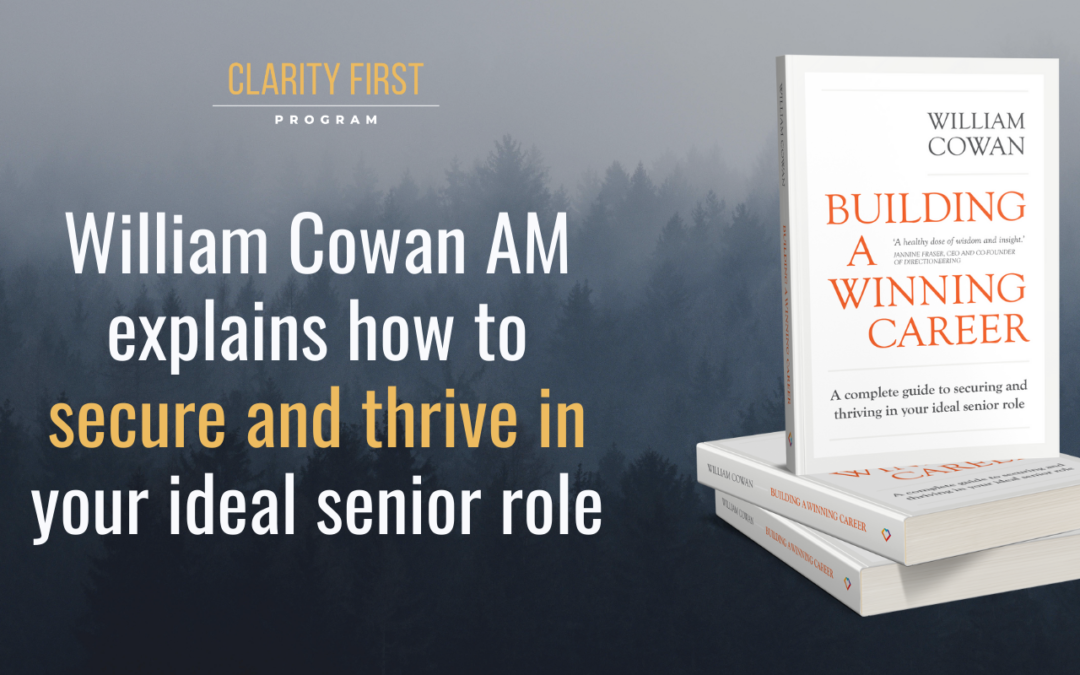
Well, Bill certainly did not disappoint in this morning's interview!
Bill shared career insights that are hugely relevant to all of us, no matter where we are in our careers.
He gave me a new idea for addressing current challenge and judging by the chat messaging others found the same.
I encourage you to take the time to watch the recording below and to consider working with him further.
Grab a copy of his new book Building a Winning Career, which launched today. He is offering the Kindle version for about $10 for the coming two weeks to make it affordable to everyone, as well as physical copies which Australians can order directly from him, or those overseas can access via online book stores.

I love what I do.
I help senior leaders and their teams prepare high-quality papers and presentations in a fraction of the time.
This involves 'nailing' the message that will quickly engage decision makers in the required outcome.
I leverage 25+ years' experience including
My approach helps anyone who needs to engage senior leaders and Boards.
Recent clients include 7Eleven, KPMG, Mercer, Meta, Woolworths.
Learn more at www.clarityfirstprogram.com
(*) Numbers are based on 2023 client benchmarking results.

When talking about the risks in a recent Board paper with two SLT members, one of them said something very interesting.
The risks section SHOULD make us feel uncomfortable.
The CTO's view was that if we highlight the things that are keeping us up at night and can demonstrate how well we have thought them through they will trust us more.
I found this interesting as I at times see risks being discussed in a ‘tick a box' fashion or alternatively being played down to reduce political rather than practical risk.
Given his view was so clear and strong vs what I so often see, I wanted to unpack his reasoning to help you too …
If we do share what keeps us up at night three things will happen. We
If, alternatively, we are ‘gilding the lily' by only discussing the positives, leaders won’t trust us – and neither they should.
In his words: if we play it safe we would let both them and ourselves down as it demonstrates that we
This was food for thought to me and will push me to focus more intently on how risks are articulated in communication I help my clients prepare.
What about you?
How openly do you discuss the risks as you see them when lying awake at night?
I hope that helps. More next week.
Kind regards,
Davina

I love what I do.
I help senior leaders and their teams prepare high-quality papers and presentations in a fraction of the time.
This involves 'nailing' the message that will quickly engage decision makers in the required outcome.
I leverage 25+ years' experience including
My approach helps anyone who needs to engage senior leaders and Boards.
Recent clients include 7Eleven, KPMG, Mercer, Meta, Woolworths.
Learn more at www.clarityfirstprogram.com
(*) Numbers are based on 2023 client benchmarking results.
Complexity is at the heart of the challenge when communicating at work.
In this workshop I address five of the common traps that make it difficult for us to engage others in complex ideas and offer ideas on how to solve them.
Click the play button below to learn more and here to download the handout and here for more program information and here for information for your manager.
CHOOSE THE LEARNING PATHWAY THAT SUITS YOU BEST …
1 – Board Paper Bootcamp – For those who want me to guide their learning journey. Complete online modules in own time and join 4 x highly interactive 90-minute workshops to practice and master the approach. Typically run each quarter, learn more here >>
2 – Clarity Hub – A self-directed option with access to a rich collection of resources, tools and templates as well as regular live working sessions and the ever-useful Pattern Picker. Join anytime here >>
3 – My Books – With Elevate and Engage, my books will help you lift the quality of your board papers and communication without the endless reworks. I share my practical approach which you can implement straight away, learn more here >>
This was the best course I have done. I was always confident in my reasoning but not as confident with presenting it, particularly to audiences that were not on my wavelength.
Davina has shown me how to organise my high level messages which gets me a better response from my audiences.
In fact, when I used the approach to present to the sales team last week half of them came up to me individually afterwards to compliment me on my presentation. That has never happened before!
Clarity First was incredibly useful for me as it has provided a framework through which I am able to structure my initial thoughts quickly and easily.
I have always been OK at delivering communications, but the tools Davina has taught me will not only make the communications clearer and more concise but the time taken to get to the end point has reduced greatly.
I recommend the course to anyone who wants to make existing skills even better or for those that want to create the foundations for great communication.
Keywords: Art and Science of communicating complex ideas, workshop, free

You know your stuff.
You have been working on it for a long time.
You have been promoted.
But now you need to deal with more senior stakeholders and nobody seems to be able to articulate what they need from you.
And, in looking at your predecessor's communication you can tell it's not how you want to communicate.
But … how do you communicate to your new leaders?
So, what if you could go from here to:
But, enough from me.
Cerise should tell her own story.
First, the email then the short video.
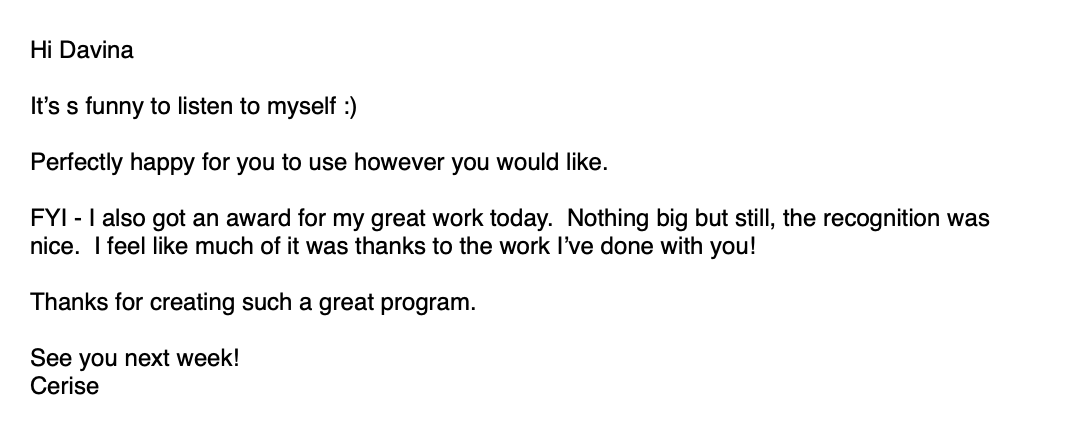
Learn how Cerise achieved this.

This post was prepared by Davina Stanley, founder of The Clarity First Program and author of The So What Strategy.
Davina has been helping experts communicate complex ideas since joining McKinsey as a communication specialist 20+ years ago.
She helps experts clarify their thinking so they can prepare powerful and strategic communication in any format. It might mean preparing for a difficult meeting, getting ready for a project steering committee, putting forward a business case or writing a board paper.
She bases her approach on The Minto Pyramid PrincipleⓇ combined with other powerful techniques to help experts of all kinds globally strengthen their communication skills.
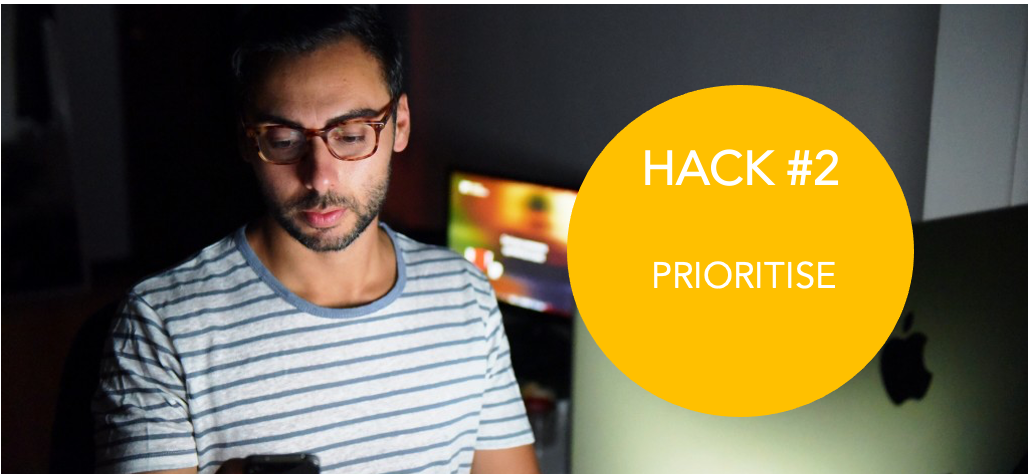
I was stunned at the shift in my perspective after filling in ‘Steve's Strategy Hack' spreadsheet for just a day and how this has continued over the past week.
Click here to read the first post in this series if you have not yet already done so.
So much so that I called him and talked about the first thing I noticed: Most of my time is spent on number ones.
In a way that is good: I am not wasting time. I am mainly working on the things that are both urgent AND important.
At least there are not many number threes or fours that according to the Eisenhower Matrix I mentioned, should be delegated or eliminated.
Interestingly, most of the number threes emerged as I realised I was doing work that others should be doing, and so should definitely be delegated. See my first few days' records here.
Now my challenge is to shift the dynamic and free up time so I can think strategically.
My sense is that by being more focused on the number twos – important but not so urgent tasks – I will be more motivated to fit more number twos into my week.
To achieve that, I turn to Michael Hyatt's Freedom Compass, which I have found to be golden.
The basic premise is that we all need to balance our proficiency and our passion to find and focus on our ‘true north' if we are to add maximum value.
The idea is that we prioritise our time so we spend more time in what Michael calls our Desire Zone. Here are four steps to help achieve this:
Step 1 – Delegate, automate and eliminate anything that belongs in our Drudgery Zone. These are low level repetitive tasks that can be done by someone else or which add less value than we should be delivering in our role.
Since starting this exercise, I have realised these categories fit into two groups: easy things and hard things.
Things that are easy to delegate, which are tasks that someone else in my team is equiped to do both in terms of time available and skills as well as their view of their responsibilities.
In our business, this might include technical problems which I pass to Sheena to solve. She built a lot of our systems and is perfectly positioned to find quick fixes or take the time to investigate more deeply if needed. For the repetitive tasks I ask her to address, she then automates them either with technology or by writing a procedure for our colleague Fatima to process.
Things that are harder to delegate, which are things that involve asking someone else to do something they either do not know how to do or do not want to do.
One of these jumped out at me this week as I was filling in Steve's Strategy Hacking Spreadsheet. In reviewing a draft document a colleague had written, I came unstuck. I reworked it completely when I should not have done so. The author had ‘flicked it to me quickly' and assumed (rightly this time!) that they could effectively delegate upwards and I would fix it.
After reworking it, however, I realised that this was not a good use of my time and I should have instead identified key opportunities for improvement (which I could do within minutes of opening) and asked for them to rework it. This would have been a better learning experience for them and also given me half an hour back as well as reduced my frustration.
Step 2 – Dealing with the things that are in our Disinterest Zone is harder, but just as essential. These are tasks that we may be good at but which frankly bore us. Having a large number of tasks in this zone is a red flag if they can't be automated or passed on to someone else.
This is one area I can get better at. It is just too easy to keep doing admin or other simple tasks which although not value adding are satisfying to the extent that they lead to ‘things being ticked off a list'.
Step 3 – Face up to items that fall in our Distraction Zone. These are items that we like to do, that may be easy for us, but which are beneath us. For example, I make for a very expensive web designer, yet this is one of my hobbies. I love tinkering around and employing some of my design skills on our sites. This is the kind of thing that should not appear too often in my ‘strategy hacker' spreadsheet though, if I am to add real value.
Going through this diagnostic audit has spurred me to action. I just posted a job ad to get someone to help me with some of my marketing activities.
Step 4 – Fire up the things that fall in our Desire Zone. This is where work becomes fun. The more we spend time here, the more value we will add. This is where our passion and proficiency intersect and we can optimise the value we add. The more time we can spend in our Desire Zone the more we will thrive as individuals and as professionals.
For me, this is now about stretching two areas: leadership and marketing. I enjoy getting better at both and can deliver significantly more impact to my business if I excel in both these areas.
Step 5 – Identify what falls into my Development Zone so I can optimise what I can deliver upon, particularly within the Desire Zone. For me this will be a mix of learning how to create more space in my schedule for things that add more value and also how to do the things that might fill that newfound space.
Given my own observations from tracking my activities over the past week, I will focus on getting better at delegating more. The challenge will be to work out what I can delegate to who as well as how to do it successfully.
This will, I hope, give me greater focus as I double down on creating the best possible online learning program and how to market it.
Clarifying this goal is is already building pressure that is motivating me to not imprison myself in a frenetic day of number ones, but rather create fortresses for number twos.
It also makes me realise how essential it is to go beyond the platitudes. The idea of diagnosing, decluttering and prioritising sounds pretty easy.
it done will require some practical tactics such as the ones shared with me by Richard Medcalf of Xquadrant recently. I will share them with you next week too.
In next week's post I will share ideas about ‘fortresses' and ‘prisons' which were just two of the terrific concepts Richard Medcalf of XQuadrant shared with me when we spoke recently.
Keep your eyes peeled for next week's interview.
PS If you enjoyed reading about the Freedom Compass, you might also enjoy Michael Hyatt's excellent book on the topic, Free to Focus. He is one of the people who has inspired me to ‘close the doors on Clarity First' so they are only open three times a year. This will, I think provide both me and my program participants with greater focus as we work to strengthen their communication skills.
Please note, this post contains Amazon affiliate links, and as an Amazon Associate I earn a small amount from qualifying purchases. This helps me cover the costs of delivering my free content to you.

I love what I do.
I help senior leaders and their teams prepare high-quality papers and presentations in a fraction of the time.
This involves 'nailing' the message that will quickly engage decision makers in the required outcome.
I leverage 25+ years' experience including
My approach helps anyone who needs to engage senior leaders and Boards.
Recent clients include 7Eleven, KPMG, Mercer, Meta, Woolworths.
Learn more at www.clarityfirstprogram.com
(*) Numbers are based on 2023 client benchmarking results.
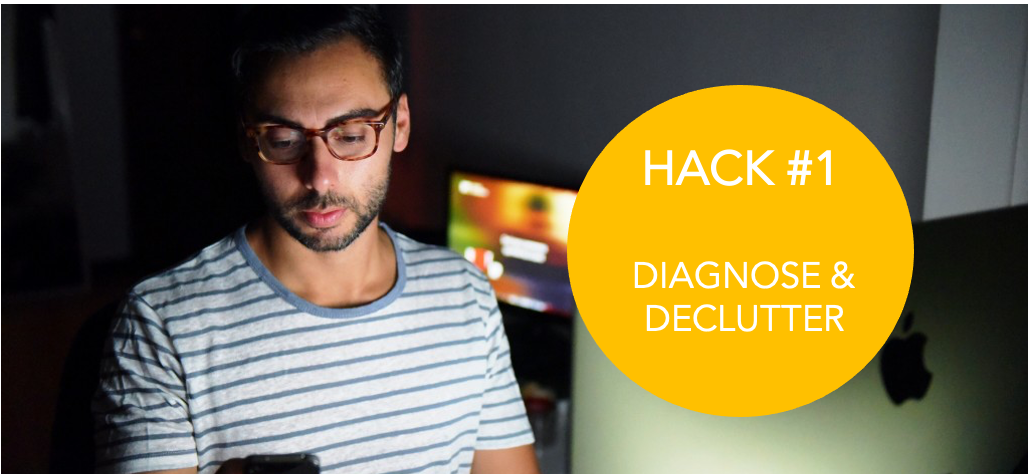
I loved catching up with a Clarity First alum this week for at least two reasons:
#1 – I love hearing how a story we have worked on together lands, and
#2 – I also love it when they can teach me something practical that they have made work for themselves which will also help someone else
Steve rang me to tell me that a major strategy I had helped him develop a couple of years ago has now come to fruition. He got pretty much everything he had aimed for at the start.
We were both delighted.
Given I know him well, I also took advantage of the conversation to ask some questions that I thought he was well placed to answer.
He is not only head of the highly successful Australian arm of a global business, he has a family, works pretty regular hours and ‘knocks off' early on a Wednesday to go sailing.
He has plenty to offer many of my clients, especially a project manager from a technology company, who said this week:
I feel like I am running soooo fast just to deliver – how do I find time to be strategic as well?
So, how did he transition from being an engineer to becoming a strategic leader who takes nights and weekends off as well as going sailing most Wednesday afternoons?
Steve offered some practical hacks for those of us who want to deliver at a more strategic level while not working 24/7.
He said some of the best advice he was given as he moved into leadership was to take control of his time.
So, I have taken his advice and plan to hack my own schedule over the coming weeks to see if I can gain the same sorts of results.
At the moment, getting to yoga on a Wednesday morning would be a sign of success. I have cancelled the last three weeks running.
Let's work out if we can ‘hack our way' to becoming more strategic and get to some fun things outside of work at the same time.
Here is the roadmap for Steve's Hacks. I'll focus one one of these each week for the coming three weeks as I also work to optimise my own schedule and corresponding impact:
Let's get started.
Step 1 – Diagnose and declutter
So, this coming week, I will focus on diagnosing what I am doing now and start to declutter my activities. Here is how Steve suggested I do it:
When interviewing Richard Medcalf of XQuadrant about ideas to help clients become more strategic, he also offered another simple idea. He recommends using a tool called RescueTime to monitor my activity.
It will check how I spend my time when at my computer, eg how much time on email, websites, Word / PowerPoint, etc. It has a 14-day free trial, so I have signed up to see if that gives me some useful information too.
So far as day one goes: it's cool. I am looking forward to shining some light on what tools I am using more and less of.
I'd love to hear how this helps you and will come back not only with Richard's interview but more thoughts over the coming weeks. Feel free to email me and share your experiences.
Talk soon,
Davina
PS If you don't normally receive my emails and want to keep up with the series, subscribe below.
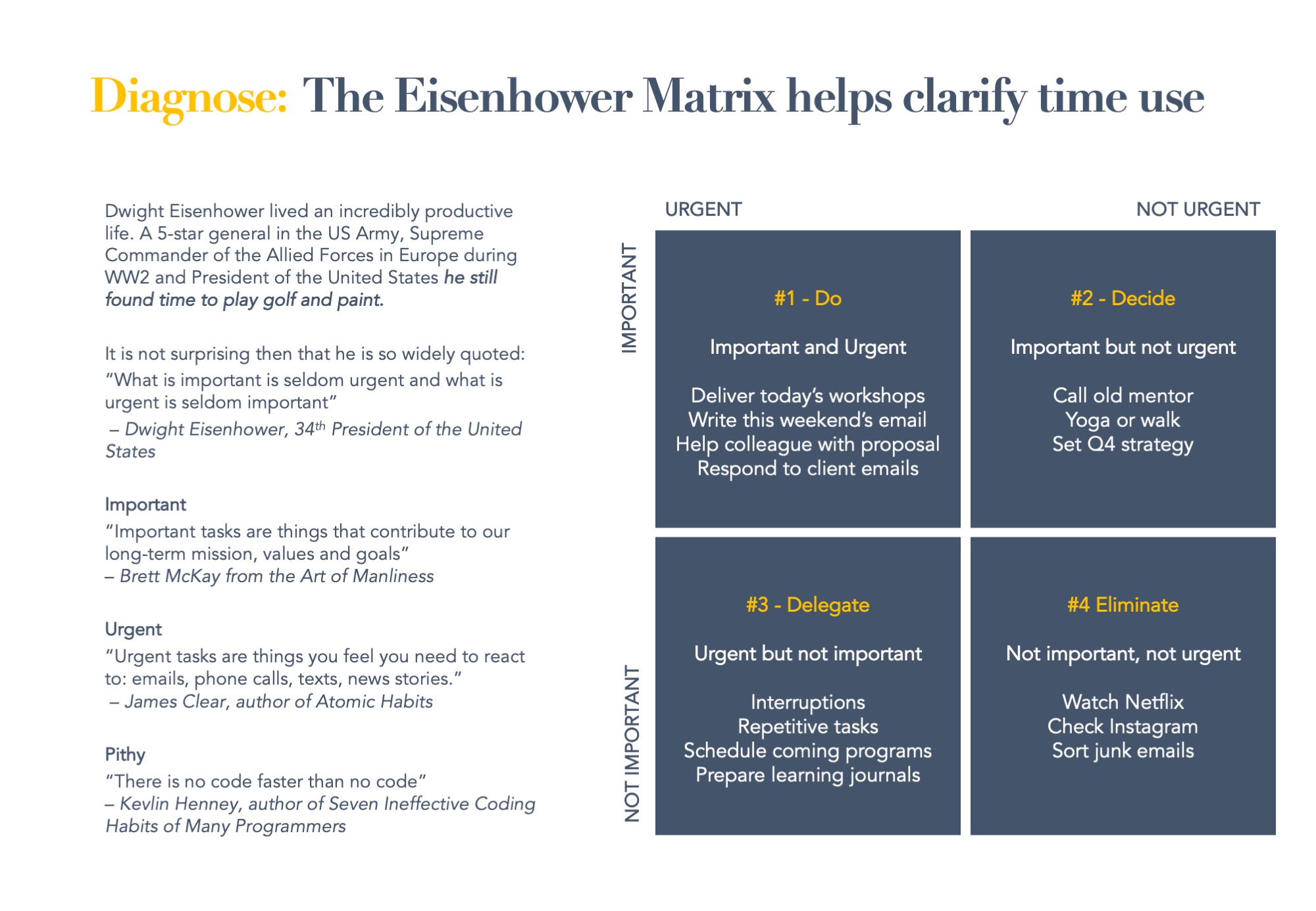

I love what I do.
I help senior leaders and their teams prepare high-quality papers and presentations in a fraction of the time.
This involves 'nailing' the message that will quickly engage decision makers in the required outcome.
I leverage 25+ years' experience including
My approach helps anyone who needs to engage senior leaders and Boards.
Recent clients include 7Eleven, KPMG, Mercer, Meta, Woolworths.
Learn more at www.clarityfirstprogram.com
(*) Numbers are based on 2023 client benchmarking results.

I am usually not a fan of completing audits.
Keeping records of minutiae has never been my strength.
But, wow.
Even though I have by no means kept a perfect record of what I have been up to over the past couple of weeks, the insights have been powerful.
They have certainly helped me get out of the weeds so I can become clearer about ways – to quote today's interview guest – multiply my impact.
Richard Medcalf of Xquadrant specialises in helping successful people do just that.
He offers a number of terrific ideas including how to:
We hope you enjoy this half-hour interview and the free resources he has for you at https://xquadrant.com/clarityfirst/ and check out his new podcast ‘Impact Multiplier CEO' wherever you normally listen to them.
To view a transcript of this discussion, please >> click here >>

I love what I do.
I help senior leaders and their teams prepare high-quality papers and presentations in a fraction of the time.
This involves 'nailing' the message that will quickly engage decision makers in the required outcome.
I leverage 25+ years' experience including
My approach helps anyone who needs to engage senior leaders and Boards.
Recent clients include 7Eleven, KPMG, Mercer, Meta, Woolworths.
Learn more at www.clarityfirstprogram.com
(*) Numbers are based on 2023 client benchmarking results.

I am usually not a fan of completing audits.
Keeping records of minutiae has never been my strength.
But, wow.
Even though I have by no means kept a perfect record of what I have been up to over the past couple of weeks, the insights have been powerful.
They have certainly helped me get out of the weeds so I can become clearer about ways – to quote today's interview guest – multiply my impact.
Richard Medcalf of Xquadrant specialises in helping successful people magnify their impact.
He offers a number of terrific ideas including how to:
And plenty more too.
>> Click here to access the interview as well as some other practical takeaways, including a checklist to help you lead strategically when there is already too much to do.

I love what I do.
I help senior leaders and their teams prepare high-quality papers and presentations in a fraction of the time.
This involves 'nailing' the message that will quickly engage decision makers in the required outcome.
I leverage 25+ years' experience including
My approach helps anyone who needs to engage senior leaders and Boards.
Recent clients include 7Eleven, KPMG, Mercer, Meta, Woolworths.
Learn more at www.clarityfirstprogram.com
(*) Numbers are based on 2023 client benchmarking results.

I was stunned at the shift in my perspective after filling in ‘Steve's Strategy Hack' spreadsheet for just a day and how this has continued over the past week.
Click here to read the first post in this series if you have not yet already done so.
So much so that I called him and talked about the first thing I noticed: Most of my time is spent on number ones.
In a way that is good: I am not wasting time. I am mainly working on the things that are both urgent AND important.
At least there are not many number threes or fours that according to the Eisenhower Matrix I mentioned, should be delegated or eliminated.
Interestingly, most of the number threes emerged as I realised I was doing work that others should be doing, and so should definitely be delegated. See my first few days' records here.
Now my challenge is to shift the dynamic and free up time so I can think strategically.
My sense is that by being more focused on the number twos – important but not so urgent tasks – I will be more motivated to fit more number twos into my week.
To achieve that, I turn to Michael Hyatt's Freedom Compass, which I have found to be golden.
The basic premise is that we all need to balance our proficiency and our passion to find and focus on our ‘true north' if we are to add maximum value.
The idea is that we prioritise our time so we spend more time in what Michael calls our Desire Zone. Here are four steps to help achieve this:
Step 1 – Delegate, automate and eliminate anything that belongs in our Drudgery Zone. These are low level repetitive tasks that can be done by someone else or which add less value than we should be delivering in our role.
Since starting this exercise, I have realised these categories fit into two groups: easy things and hard things.
Things that are easy to delegate, which are tasks that someone else in my team is equiped to do both in terms of time available and skills as well as their view of their responsibilities.
In our business, this might include technical problems which I pass to Sheena to solve. She built a lot of our systems and is perfectly positioned to find quick fixes or take the time to investigate more deeply if needed. For the repetitive tasks I ask her to address, she then automates them either with technology or by writing a procedure for our colleague Fatima to process.
Things that are harder to delegate, which are things that involve asking someone else to do something they either do not know how to do or do not want to do.
One of these jumped out at me this week as I was filling in Steve's Strategy Hacking Spreadsheet. In reviewing a draft document a colleague had written, I came unstuck. I reworked it completely when I should not have done so. The author had ‘flicked it to me quickly' and assumed (rightly this time!) that they could effectively delegate upwards and I would fix it.
After reworking it, however, I realised that this was not a good use of my time and I should have instead identified key opportunities for improvement (which I could do within minutes of opening) and asked for them to rework it. This would have been a better learning experience for them and also given me half an hour back as well as reduced my frustration.
Step 2 – Dealing with the things that are in our Disinterest Zone is harder, but just as essential. These are tasks that we may be good at but which frankly bore us. Having a large number of tasks in this zone is a red flag if they can't be automated or passed on to someone else.
This is one area I can get better at. It is just too easy to keep doing admin or other simple tasks which although not value adding are satisfying to the extent that they lead to ‘things being ticked off a list'.
Step 3 – Face up to items that fall in our Distraction Zone. These are items that we like to do, that may be easy for us, but which are beneath us. For example, I make for a very expensive web designer, yet this is one of my hobbies. I love tinkering around and employing some of my design skills on our sites. This is the kind of thing that should not appear too often in my ‘strategy hacker' spreadsheet though, if I am to add real value.
Going through this diagnostic audit has spurred me to action. I just posted a job ad to get someone to help me with some of my marketing activities.
Step 4 – Fire up the things that fall in our Desire Zone. This is where work becomes fun. The more we spend time here, the more value we will add. This is where our passion and proficiency intersect and we can optimise the value we add. The more time we can spend in our Desire Zone the more we will thrive as individuals and as professionals.
For me, this is now about stretching two areas: leadership and marketing. I enjoy getting better at both and can deliver significantly more impact to my business if I excel in both these areas.
Step 5 – Identify what falls into my Development Zone so I can optimise what I can deliver upon, particularly within the Desire Zone. For me this will be a mix of learning how to create more space in my schedule for things that add more value and also how to do the things that might fill that newfound space.
Given my own observations from tracking my activities over the past week, I will focus on getting better at delegating more. The challenge will be to work out what I can delegate to who as well as how to do it successfully.
This will, I hope, give me greater focus as I double down on creating the best possible online learning program and how to market it.
Clarifying this goal is is already building pressure that is motivating me to not imprison myself in a frenetic day of number ones, but rather create fortresses for number twos.
It also makes me realise how essential it is to go beyond the platitudes. The idea of diagnosing, decluttering and prioritising sounds pretty easy.
it done will require some practical tactics such as the ones shared with me by Richard Medcalf of Xquadrant recently. I will share them with you next week too.
In next week's post I will share ideas about ‘fortresses' and ‘prisons' which were just two of the terrific concepts Richard Medcalf of XQuadrant shared with me when we spoke recently.
Keep your eyes peeled for next week's interview.
PS If you enjoyed reading about the Freedom Compass, you might also enjoy Michael Hyatt's excellent book on the topic, Free to Focus. He is one of the people who has inspired me to ‘close the doors on Clarity First' so they are only open three times a year. This will, I think provide both me and my program participants with greater focus as we work to strengthen their communication skills.
Please note, this post contains Amazon affiliate links, and as an Amazon Associate I earn a small amount from qualifying purchases. This helps me cover the costs of delivering my free content to you.

I love what I do.
I help senior leaders and their teams prepare high-quality papers and presentations in a fraction of the time.
This involves 'nailing' the message that will quickly engage decision makers in the required outcome.
I leverage 25+ years' experience including
My approach helps anyone who needs to engage senior leaders and Boards.
Recent clients include 7Eleven, KPMG, Mercer, Meta, Woolworths.
Learn more at www.clarityfirstprogram.com
(*) Numbers are based on 2023 client benchmarking results.